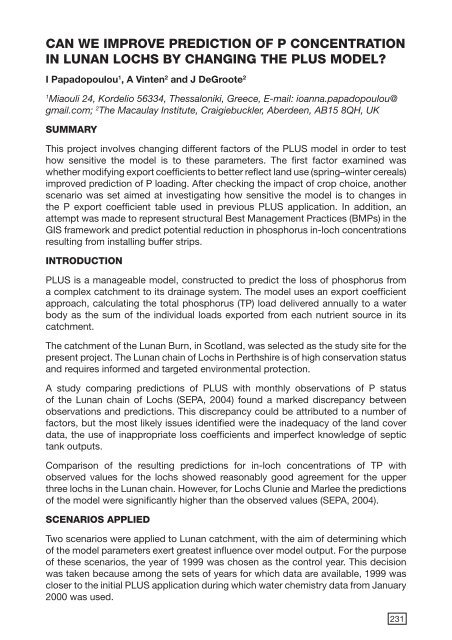Download as a PDF - CiteSeerX
Download as a PDF - CiteSeerX
Download as a PDF - CiteSeerX
Create successful ePaper yourself
Turn your PDF publications into a flip-book with our unique Google optimized e-Paper software.
CAN WE IMPROVE PREDICTION OF P CONCENTRATION<br />
IN LUNAN LOCHS BY CHANGING THE PLUS MODEL?<br />
I Papadopoulou 1 , A Vinten 2 and J DeGroote 2<br />
1<br />
Miaouli 24, Kordelio 56334, Thessaloniki, Greece, E-mail: ioanna.papadopoulou@<br />
gmail.com; 2 The Macaulay Institute, Craigiebuckler, Aberdeen, AB15 8QH, UK<br />
SUMMARY<br />
This project involves changing different factors of the PLUS model in order to test<br />
how sensitive the model is to these parameters. The first factor examined w<strong>as</strong><br />
whether modifying export coefficients to better reflect land use (spring–winter cereals)<br />
improved prediction of P loading. After checking the impact of crop choice, another<br />
scenario w<strong>as</strong> set aimed at investigating how sensitive the model is to changes in<br />
the P export coefficient table used in previous PLUS application. In addition, an<br />
attempt w<strong>as</strong> made to represent structural Best Management Practices (BMPs) in the<br />
GIS framework and predict potential reduction in phosphorus in-loch concentrations<br />
resulting from installing buffer strips.<br />
INTRODUCTION<br />
PLUS is a manageable model, constructed to predict the loss of phosphorus from<br />
a complex catchment to its drainage system. The model uses an export coefficient<br />
approach, calculating the total phosphorus (TP) load delivered annually to a water<br />
body <strong>as</strong> the sum of the individual loads exported from each nutrient source in its<br />
catchment.<br />
The catchment of the Lunan Burn, in Scotland, w<strong>as</strong> selected <strong>as</strong> the study site for the<br />
present project. The Lunan chain of Lochs in Perthshire is of high conservation status<br />
and requires informed and targeted environmental protection.<br />
A study comparing predictions of PLUS with monthly observations of P status<br />
of the Lunan chain of Lochs (SEPA, 2004) found a marked discrepancy between<br />
observations and predictions. This discrepancy could be attributed to a number of<br />
factors, but the most likely issues identified were the inadequacy of the land cover<br />
data, the use of inappropriate loss coefficients and imperfect knowledge of septic<br />
tank outputs.<br />
Comparison of the resulting predictions for in-loch concentrations of TP with<br />
observed values for the lochs showed re<strong>as</strong>onably good agreement for the upper<br />
three lochs in the Lunan chain. However, for Lochs Clunie and Marlee the predictions<br />
of the model were significantly higher than the observed values (SEPA, 2004).<br />
SCENARIOS APPLIED<br />
Two scenarios were applied to Lunan catchment, with the aim of determining which<br />
of the model parameters exert greatest influence over model output. For the purpose<br />
of these scenarios, the year of 1999 w<strong>as</strong> chosen <strong>as</strong> the control year. This decision<br />
w<strong>as</strong> taken because among the sets of years for which data are available, 1999 w<strong>as</strong><br />
closer to the initial PLUS application during which water chemistry data from January<br />
2000 w<strong>as</strong> used.<br />
231

















